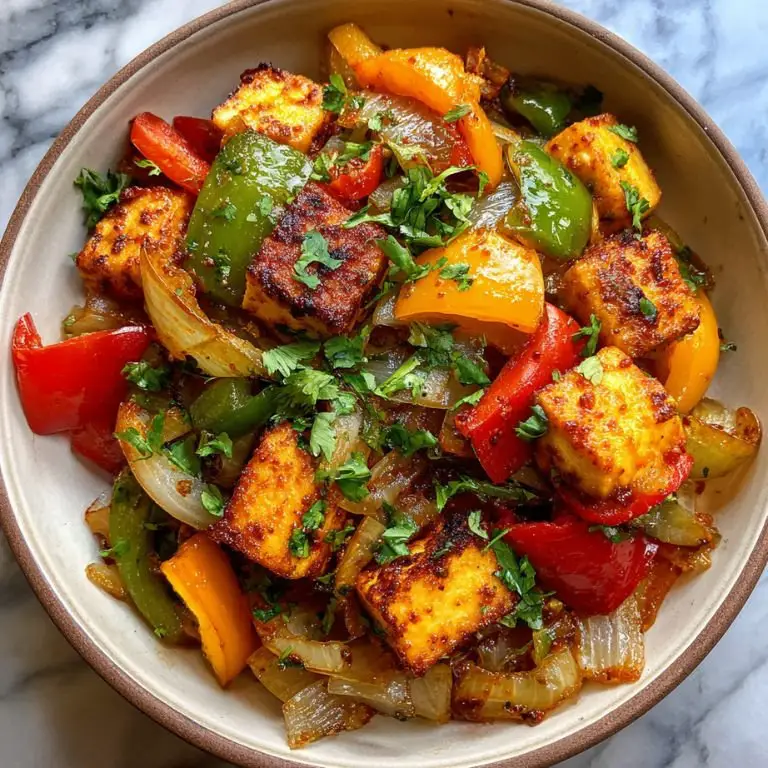This vibrant Paneer Sabzi is a Punjabi-inspired mix veg sabzi recipe that comes alive with succulent bell peppers and sweet onions, pan-seared and tossed with tender cubes of paneer. It’s a no-fuss, dry vegetable recipe that’s perfect for dinner recipes when you’re craving satisfying desi food flavors without too much oil or effort. Think juicy peppers, buttery onions, and soft Indian vegetables sautéed together in a shallow gravy of spices—this paneer sabji vegetarian treat brings Punjabi food energy straight to your kitchen. Whether you’re working on indian cooking recipes or simply hunting a new veg sabji recipe, this sabji vegetarian dish is sure to brighten your weeknight table.
Paneer Sabzi with Bell Peppers and Onions
Prep Time 20 minutes mins
Cook Time 15 minutes mins
Total Time 35 minutes mins
Course Main Course
Cuisine Indian
Large pan or wok (kadhai) Ideal for stir-frying the sabji.
Mixing bowls One for tossing paneer, another for prepping veggies.
Sharp knife and board For clean slicing of bell peppers and onions.
Spatula or wooden spoon For stirring.
Plate lined with paper towels Handy if you choose to shallow-fry the paneer lightly before adding to the sabji.
- 300 g paneer cut into 1" cubes
- 1 large red bell pepper cut into chunks
- 1 large yellow bell pepper cut into chunks
- 1 large green bell pepper cut into chunks
- 2 medium onions thinly sliced into half-moons
- 2 medium tomatoes chopped (optional, for a slightly saucier twist)
- 2 green chilies slit lengthwise (adjust to taste)
- 1 tbsp ginger-garlic paste
- 2 tbsp oil vegetable, canola, or sunflower
- 1 tsp cumin seeds
- ½ tsp turmeric powder
- 1 tsp coriander powder
- 1 tsp cumin powder
- ½ tsp red chili powder adjust if you prefer mild
- ½ tsp garam masala
- Salt to taste
- Fresh coriander leaves chopped, for garnish
- A squeeze of lemon juice optional, for brightness
Prep the Paneer
Cut the paneer into even 1" cubes. Optionally, toss them in a light drizzle of oil, a pinch of salt, and a few cracks of black pepper. This helps prevent sticking and adds a touch of flavor. If you want a golden crust, shallow-fry the cubes in a little oil until lightly browned, then transfer onto paper towels.
Slice Bell Peppers and Onions
Cut the bell peppers into chunks and onions into half-moons. Keep them roughly the same size for even cooking. The contrast of red, yellow, and green peppers makes the sabji visually striking, like a vibrant Punjabi food medley.
Temper the Spices
Heat oil in a wok or large skillet over medium-high heat. Once shimmering, add cumin seeds. Let them sputter for about 10 seconds, then stir in the ginger-garlic paste and green chilies, sautéing until fragrant (30–45 seconds).
Build the Sabji
Add onions and cook until translucent, about 2 minutes. Then toss in the bell peppers. Sauté for 4–5 minutes until peppers soften but retain a little crunch—this keeps the sabji lively and fresh. If using tomatoes, add them now and cook until they break down into a light saucy base.
Spice It Up
Sprinkle turmeric, coriander, cumin, and red chili powders over the vegetables. Stir well to coat. Simmer for another 2 minutes so the spices bloom. Add salt to taste. If you notice the sabji drying out, splash in a couple of tablespoons of water to keep it moist (still remains a dry vegetable recipe).
Add Paneer
Gently fold in the paneer cubes until everything is evenly mixed. Sprinkle garam masala over the top, stir once more, and cook for another 2 more minutes just to warm the paneer through—avoid overcooking, or it becomes rubbery.
Final Touches
Finish with chopped fresh coriander and a squeeze of lemon juice. The citrus lift freshens the sabji, balancing the warmth of spices.
Serve hot with chapati, paratha, jeera rice, or as part of a festive Indian sabji recipe spread. This versatile paneer dish works with roti for a simple everyday dinner or alongside pulav and dal for a more elaborate punjabi food spread.
Pairings
- Roti or Paratha
Classic whole-wheat roti or buttery aloo paratha pairs beautifully, soaking up the aromatic juices.
- Jeera Rice
Lightly spiced cumin rice adds gentle warmth without overpowering the sabji.
- Grilled Flatbread
Naan or tandoori roti bring a smoky edge—ideal if you’ve got a naan-making day.
- Refreshing Salad
A crisp cucumber, tomato, and onion salad drizzled with lemon juice complements the sabji’s richness.
- Yogurt Side
Plain yogurt or a simple raita (cucumber or boondi) calms the palate and balances heat.
- Dal Tadka
A bowl of yellow dal with a smoky tempering enhances the protein in the meal.
- Pickles and Chutneys
Mango pickle or mint chutney adds zing and traditional Indian tang.
FAQs
1. Can I use frozen bell peppers?
Yes! Thawed frozen strips work well. Pat them dry and sauté a little longer to evaporate body-dulling moisture and keep the sabji on the dry side.
2. What cut of paneer works best?
Firm or extra-firm paneer is ideal because it holds shape. Soft or fresh paneer may break down too much. If needed, press homemade paneer overnight between weighted boards to firm it up.
3. Is this vegetarian or vegan?
The recipe is vegetarian. To make it vegan, swap paneer for tofu: use firm tofu, lightly pan-sear it, then proceed with the recipe. You’ll get a vegan saag aloo vibe but with the boldness of this sabji.
4. Can I make this sabji ahead of time?
Yes, prep and cook up to step 5 in advance. Just before serving, sauté again with paneer and garnish fresh—it tastes freshly cooked.
5. Can I add other vegetables?
Absolutely! Mix veg sabzi variations could include sliced mushrooms, cubed cauliflower (gobhi sabzi influence), or baby corn. Just toss them in with the bell peppers—adjust cooking times so everything finishes together.
